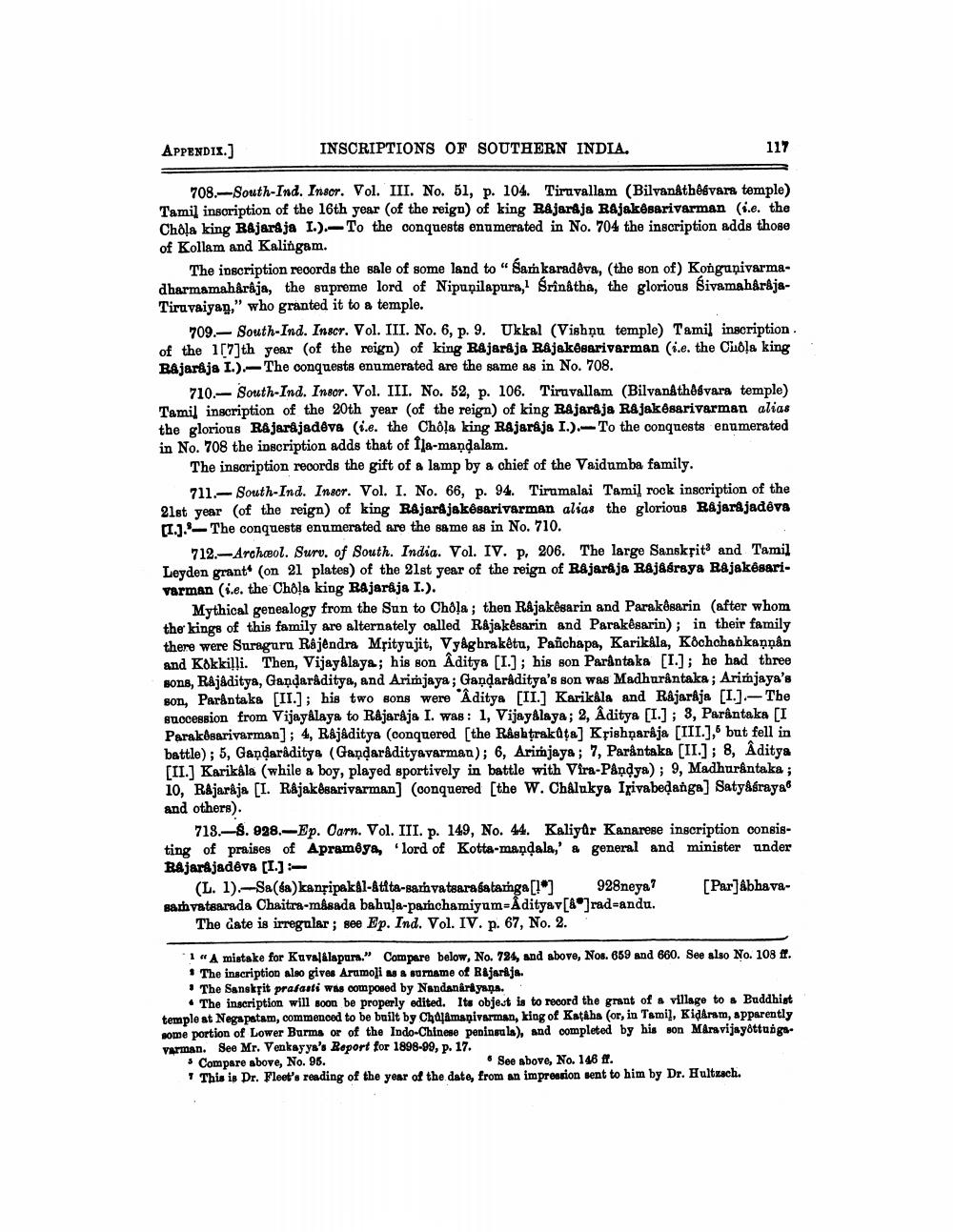________________
APPENDIX.)
INSCRIPTIONS OF SOUTHERN INDIA.
117
708.-South-Ind. Insor. Vol. III. No. 51, p. 104. Tiruvallam (BilvanAthekvara temple) Tamil insoription of the 16th year of the reign of king Rajaraja Rajakesarivarman (i.e. the Chôļa king Rajaraja L.).- To the conquests enumerated in No. 704 the inscription adds those of Kollam and Kalingam.
The inscription records the sale of some land to "Sam karadêya, (the son of) Konganivarmadharmamah&raja, the supreme lord of Nipupilapura, Srinatha, the glorious SivamaharajaTiruvaiyag," who granted it to a temple.
709.- South-Ind. Inscr. Vol. III. No. 6, p. 9. Ukkal (Vishnu temple) Tamil inscription. of the 1[7]th year (of the reign) of king R&jargja R&jakbearivarman (ie. the Cioļa king BAjardja I.), The conquests enumerated are the same as in No. 708.
210.- South-Ind. Insor. Vol. III. No. 52, p. 106. Timavallam (BilvanAthivara temple) Tamil inscription of the 20th year of the reign) of king Rajaraja Rajakesarivarman alias the glorious Rajarajadeva (i.e. the Chola king Rajaraja I.). To the conquests enumerated in No. 708 the inscription adds that of Ila-mandalam.
The inscription records the gift of a lamp by a chief of the Vaidumba family.
211.- South-Ind. Insor. Vol. I. No. 66, p. 94. Tirumalai Tamil rock inscription of the 21st year of the reign) of king Rajardjakesarivarman alias the glorious R&jarajadêva [1.. The conquests enumerated are the same as in No. 710.
712.-Archeol. Suru. of South India. Vol. IV. p. 206. The large Sanskrit and Tamil Leyden grant (on 21 plates) of the 21st year of the reign of Rajaraja Rajasraya Rajakesarivarman (i.e. the Chola king Rajaraja I.).
Mythical genealogy from the Sun to Chola; then Rajakesarin and Parak@sarin (after whom the kings of this family are alternately called Rajakesarin and Parakesarin); in their family there were Suraguru Rajendra Mrityujit, Vy&gbraketu, Pañchapa, Karikala, Kochchankannan and Kokkiļļi. Then, Vijayalaya; his son Aditya [I.] ; his son Parantaka [I.]; he had three Bons, Rajaditya, Gandaraditya, and Arimjaya; Gandaráditya's son was Madhuråntaka; Arinjaya's son, Parantaka (II.); his two sons were 'Aditya [II.] Karikala and Rajaraja [I.].-The succession from Vijayalaya to Rajaraja I. was: 1, Vijayalaya; 2, Aditya [I.] ; 3, Parantaka (I Parakharivarman); 4, Rajaditya (conquered [the Rashtrakata) Krishnaraja [III.], but fell in battle); 5, Gandaråditya (Gandarâdityavarman); 6, Arimjaya ; 7, Parântaka (II.] ; 8, Âditya [II.] Karikála (while a boy, played sportively in battle with Vira-Pandya); 9, Madhurântaka ; 10, Rajaraja (1. Rajakesarivarman] (conquered [the W. Chalukya Igivabedanga] Satyásraya and others).
713.-8. 028.-Ep. Oarn. Vol. III. p. 149, No. 44. Kaliyar Kanarese inscription consisting of praises of Apram@ya, lord of Kotta-mandala,' a general and minister under Rajarajadêvs [I.] -
(L. 1).-Sa(fa)kansipakAl-Atita-sarvatsarasatanga[?] 928neya? [Par]Abhavasathvatsarada Chaitra-m&sada bahula-panchamiyum-Adityav[&]rad-andu.
The Gate is irregular ; see Ep. Ind. Vol. IV. p. 67, No. 2.
1 « A mistake for Kavaldlapun." Compare below, No. 724, and above, Nos. 659 and 660. See also No. 108 fr. • The inscription also gives Arumojima surname of Rijarijs. · The Sanskrit prarasti wis composed by Nandanarayana. .
• The inscription will soon be properly edited. Its objest is to record the grant of a village to Buddhist temple at Negapatam, commenced to be built by Chalamaņivarman, king of Katha (or, in Tamil, Kidaram, apparently some portion of Lower Burms or of the Indo-Chinese peninsula), and completed by his son Måra vijayottungsVarman. See Mr. Venkayya's Report for 1898-99, p. 17. Compare above, No. 95.
See above, No. 146 ff. This is Dr. Fleet'e reading of the year of the date, from an impression sent to him by Dr. Hultzach.




